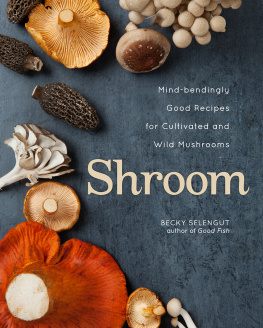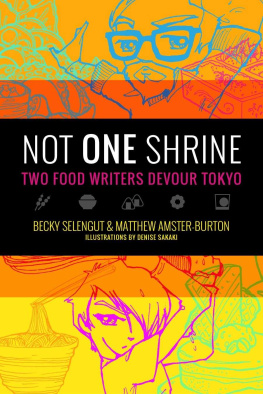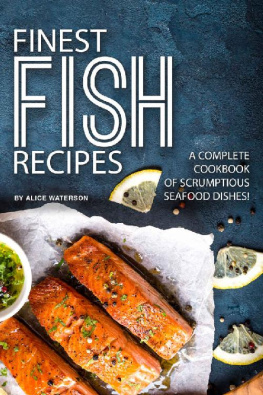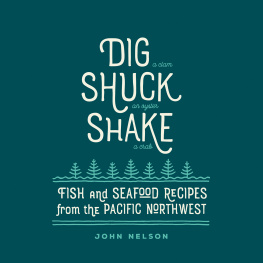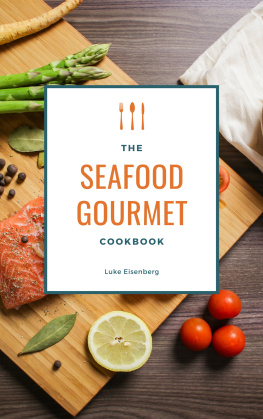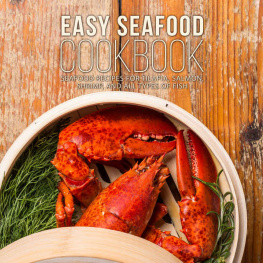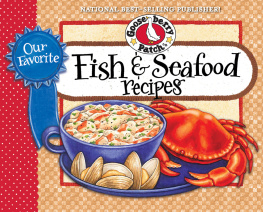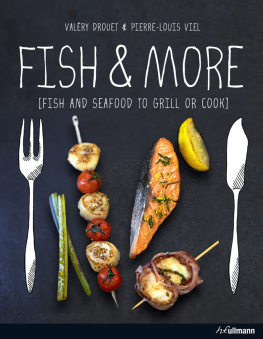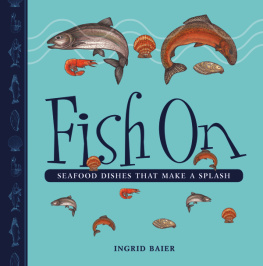acknowledgments
To my army of recipe testers, tasters, advisors, and friends, I bow deeply upon one knee: Carrie Kincaid, Heather Diller, Heather Weiner, Becky Ginn, Kim Allen, Maxine Williams, Elaine Hackett, Marc Schermerhorn, David Wiley, Lorna Yee, Henry Lo, Derek Slager, Chris Nishiwaki, Larry Liang, Kristen Ramer Liang, Hans Giner, Catherine Moon Giner, Elaine Mowery, Gordon King, Anna Berman, Shannon and Jason Mullett-Bowlsby, Michael Anderson, Shirley Abreu, Jenise Silva, Matthew Amster-Burton, John Tippett, Allison Day, Gregory Heller, Erika Garcia, Judy Niver, Oyster Bill Whitlock, everyone at Mutual Fish, Nancy Harvey, Shauna James Ahern, Dan Ahern, Amy Duchene, Sue Skillman, Ryan Breske, Hsiao-Ching Chou, Rebekah Denn, Nancy Leson, Janis Martin, Emily Wines, Jake Kosseff, Doug Derham, Miki Tamura, Mona Memmer, Janis Fulton, Therese Ogle, Mimi Southwood, Ba Culbert and the staff at Tilikum Place Caf, Susan Actor, Lisa Fisher, Caro Horsfall, Lara Muffley, Melissa Poe, J. Christian Andrilla, Langdon Cook, Rocky Yeh, and the Food Whores. A big sloppy kiss to Denise Anderson, the queen of recipe testers.
Elizabeth Walesthank you for sharing your expertise with me, above and beyond that of a good neighbor.
Jill Lightner of Edible Seattle, Jackie DeCicco of PCC Cooks, and Giselle Smith of Seattle Homes and Lifestyleseach of you makes me a better writer every time I work with you, and I greatly appreciate how supportive you are of my passion for all things seafood (and an occasional missed deadline or five).
They may not be aware of their membership, but the following people are all on my Seafood Advisory Committee; they are fishermen and renowned experts in their fields who have graciously donated their time to advise me on issues of seafood sustainability. Thank you to Jeremy Brown and Rich Childers for your expert review, and to Nick Furman of the Oregon Dungeness Crab Commission. My eternal appreciation to Casson Trenor for your knowledge, passion, love of sushi, and quick pickup on the phone whenever I needed you; Jon Rowley, for inspiring me with all your love and appreciation for the inherent deliciousness of life; Rick Moonen, for being one of the most colorful advocates for the oceans Ive ever had the pleasure of meetingand an incredible chef, to boot; Hajime Sato, for following your heart and taking the huge risk of changing your business in favor of sustainable sushi; Jacqueline Church, for your support and long-standing commitment to sustainable seafood; and Marco Pinchot, for giving so freely of your time and knowledge in guiding our little rat pack on your shellfish-farming tours. Amy Grondin, many thanks for being my go-to fish expert and sustainable seafood compadre for the last four years: you are a generous, knowledge-seeking, fish-lovin woman; you are the salt of the ocean and have been hugely helpful in getting my facts right for this book.
Amy Pennington, thank you for introducing me to Susan Roxborough, my editor extraordinaire at Sasquatch Books, who brought this idea to my door, appreciated my voice in all its snark (well, maybe not all), and took a chance on giving me so many pages. Thanks to all the folks at Sasquatch, specifically publisher Gary Luke, Rachelle Long (production editor goddess!), Diane Sepanski (copy editor goddess!), Anna Goldstein (designer goddess!), and Lisa Gordanier (proofreader goddess!).
Clare Barboza, working with you has been like finding a missing limb that looks remarkably like a camera that takes both the shots I imagine in my head but cant produce, and the shots I never had the vision to see in the first place.
Jerry Traunfeld, I consider you my mentor, and it seems fitting that most of this book was written at your restaurant, Poppy, while sitting at the bar drinking a Papi Delicious, tapping away at my computer, and eating some of the most extraordinarily prepared seafood dishes on the Pacific Coast. Thanks to all your staff at Poppy for taking such great care of me and April.
Jeanette Smith and Ashlyn Forshner, my wing(wo)men, you two deserve a weeks stay in a spa (yes, Ill rub your feet) for all the help and heart you contributed to this bookit wouldnt be half of what it is without your creativity, humor, and gentle guidance. Food adventures would not be the same without you both.
Mark Malamud, Susan Hautala, and Jasper Malamud, you are my patrons, friends, family, clients, and guinea pigsyour kitchen has been my test kitchen for ten years and counting. This book is as much yours as it is mine.
Some food-and-wine pairings are so sublime that the food makes an already good wine sing, and the wine makes an enjoyable dish unforgettableand that is precisely how I think of my partnership with April Pogue. Sharing a life of food and wine with April makes everything better.
appendix a: a note on eating raw seafood
Id like to clear up a few misconceptions. Some people are scared to eat sushi, or more accurately, raw fish. They are afraid it will make them sick. I can understandI felt the same way when my oldest brother and sister-in-law first tried to tempt me with ruby-red slabs of tuna and meltingly tender bites of yellowtail. I dont want to get sick, I protested, and they just shook their heads and said, More for us!
Im not a microbiologist, but I would reckon that a warmish bowl of cooked rice left out for hours is more likely to make you sick than chilled raw fish in the cold case or a scallop crudo. One thing people dont realize is that the majority of fish you are served in the raw (with some exceptions) has been frozen before it gets to your plate. This is a good thingnot a sign of inferior quality. You want your fish to have been frozen if you eat it raw because deep-freezing kills parasites. This is especially important with salmon, which is prone to parasites. Please, for your own health and the health of your family, do not eat raw fresh salmon at home. And before you get the notion that you can just throw your salmon fillet in a home freezer for a few days before you eat it raw (or cure it), know this: a home freezer isnt kept cold enough to kill those parasites. If you are going to cure or prepare salmon sushi, buy high-quality fish that you know has been commercially frozen.
The following is taken directly from the Food and Drug Administrations web-site: Freezing and storing at4F (20C) or below for 7 days (total time), or freezing at31F (35C) or below until solid and storing at31F (35C) or below for 15 hours, or freezing at31F (35C) or below until solid and storing at4F (20C) or below for 24 hours is sufficient to kill parasites. FDAs Food Code recommends these freezing conditions to retailers who provide fish intended for raw consumption. Another misconception? There is no legal definition of sushi-grade. It is and always has been a marketing term.
While we are on the topic of misconceptions, cooking raw fish in acid, as when you make seviche, does not eliminate parasitic contamination. It alters the protein, firming it up and changing the color of the fish, but it does not make it safe to eat. I use commercially frozen and then thawed fish when I make seviche.
The truth is that cooking food is always the safest way to go. This applies to all foods, not just fish. These days, if you are still buying bagged commercial lettuce, you may want to cook that too. I jest, but not entirely. If you are immune compromised, pregnant, or very young, its important to reduce your risks. Cooking food is a great way to do that. But for the rest of us, eating your fish raw shouldnt scare youjust take appropriate precautions.
It is actually illegal to serve raw fish in the United States unless it has first been frozen. The only exceptions to this rule are shellfish and tuna (as a deep-sea fish, tuna is exceptionally clean and free of parasites). Sushi bars dont advertise this fact because we Americans are pretty hung up on the idea that fresh fish is always superior. My thought is, unless you want to be sick, youll reconsider this bias. Once you find out your fish has been in the deep freeze, eat it raw to your hearts content, keeping in mind that you still need to keep it cold and safe from cross-contamination, since you are not cooking it. Deliciousness awaits. Much to my brothers chagrin, he no longer gets the lions share of the sushi.


